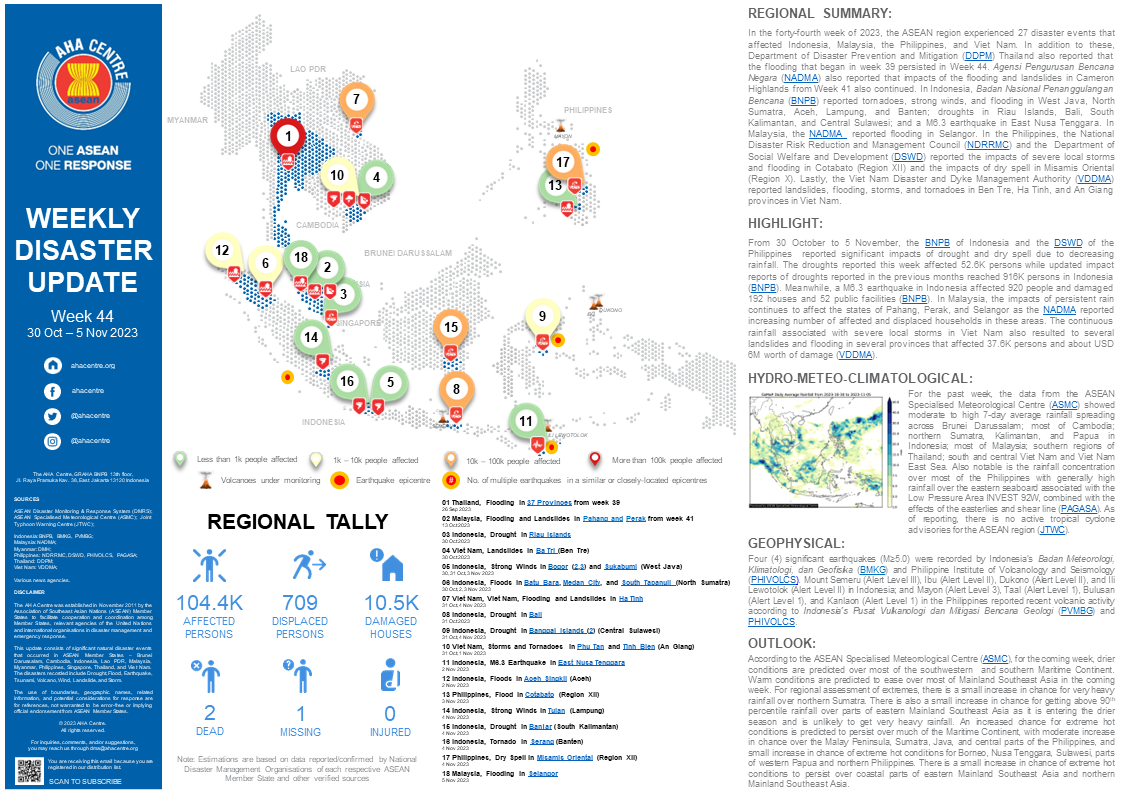
REGIONAL SUMMARY:
In the forty-fourth week of 2023, the ASEAN region experienced 27 disaster events that affected Indonesia, Malaysia, the Philippines, and Viet Nam. In addition to these, Department of Disaster Prevention and Mitigation (DDPM) Thailand also reported that the flooding that began in week 39 persisted in Week 44. Agensi Pengurusan Bencana Negara (NADMA) also reported that impacts of the flooding and landslides in Cameron Highlands from Week 41 also continued. In Indonesia, Badan Nasional Penanggulangan Bencana (BNPB) reported tornadoes, strong winds, and flooding in West Java, North Sumatra, Aceh, Lampung, and Banten; droughts in Riau Islands, Bali, South Kalimantan, and Central Sulawesi; and a M6.3 earthquake in East Nusa Tenggara. In Malaysia, the NADMA reported flooding in Selangor. In the Philippines, the National Disaster Risk Reduction and Management Council (NDRRMC) and the Department of Social Welfare and Development (DSWD) reported the impacts of severe local storms and flooding in Cotabato (Region XII) and the impacts of dry spell in Misamis Oriental (Region X). Lastly, the Viet Nam Disaster and Dyke Management Authority (VDDMA) reported landslides, flooding, storms, and tornadoes in Ben Tre, Ha Tinh, and An Giang provinces in Viet Nam.
HIGHLIGHT:
From 30 October to 5 November, the BNPB of Indonesia and the DSWD of the Philippines reported significant impacts of drought and dry spell due to decreasing rainfall. The droughts reported this week affected 52.6K persons while updated impact reports of droughts reported in the previous months reached 916K persons in Indonesia (BNPB). Meanwhile, a M6.3 earthquake in Indonesia affected 920 people and damaged 192 houses and 52 public facilities (BNPB). In Malaysia, the impacts of persistent rain continues to affect the states of Pahang, Perak, and Selangor as the NADMA reported increasing number of affected and displaced households in these areas. The continuous rainfall associated with severe local storms in Viet Nam also resulted to several landslides and flooding in several provinces that affected 37.6K persons and about USD 6M worth of damage (VDDMA).
HYDRO-METEO-CLIMATOLOGICAL:
For the past week, the data from the ASEAN Specialised Meteorological Centre (ASMC) showed moderate to high 7-day average rainfall spreading across Brunei Darussalam; most of Cambodia; northern Sumatra, Kalimantan, and Papua in Indonesia; most of Malaysia; southern regions of Thailand; south and central Viet Nam and Viet Nam East Sea. Also notable is the rainfall concentration over most of the Philippines with generally high rainfall over the eastern seaboard associated with the Low Pressure Area INVEST 92W, combined with the effects of the easterlies and shear line (PAGASA). As of reporting, there is no active tropical cyclone advisories for the ASEAN region (JTWC).
GEOPHYSICAL:
Four (4) significant earthquakes (M>5.0) were recorded by Indonesia’s Badan Meteorologi, Klimatologi, dan Geofisika (BMKG) and Philippine Institute of Volcanology and Seismology (PHIVOLCS). Mount Semeru (Alert Level III), Ibu (Alert Level II), Dukono (Alert Level II), and Ili Lewotolok (Alert Level II) in Indonesia; and Mayon (Alert Level 3), Taal (Alert Level 1), Bulusan (Alert Level 1), and Kanlaon (Alert Level 1) in the Philippines reported recent volcanic activity according to Indonesia’s Pusat Vulkanologi dan Mitigasi Bencana Geologi (PVMBG) and PHIVOLCS.
OUTLOOK:
According to the ASEAN Specialised Meteorological Centre (ASMC), for the coming week, drier conditions are predicted over most of the southwestern and southern Maritime Continent. Warm conditions are predicted to ease over most of Mainland Southeast Asia in the coming week. For regional assessment of extremes, there is a small increase in chance for very heavy rainfall over northern Sumatra. There is also a small increase in chance for getting above 90th percentile rainfall over parts of eastern Mainland Southeast Asia as it is entering the drier season and is unlikely to get very heavy rainfall. An increased chance for extreme hot conditions is predicted to persist over much of the Maritime Continent, with moderate increase in chance over the Malay Peninsula, Sumatra, Java, and central parts of the Philippines, and small increase in chance of extreme hot conditions for Borneo, Nusa Tenggara, Sulawesi, parts of western Papua and northern Philippines. There is a small increase in chance of extreme hot conditions to persist over coastal parts of eastern Mainland Southeast Asia and northern Mainland Southeast Asia.
Sources:
ASEAN Disaster Monitoring & Response System (DMRS); ASEAN Specialised Meteorological Centre (ASMC); Joint Typhoon Warning Centre (JTWC);
Indonesia: BNPB, BMKG, PVMBG;
Malaysia: NADMA;
Myanmar: DMH;
Philippines: NDRRMC, DSWD, PHIVOLCS, PAGASA;
Thailand: DDPM;
Viet Nam: VDDMA;
Various news agencies.







